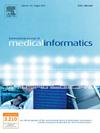Relationship prediction between clinical subtypes and prognosis of critically ill patients with cirrhosis based on unsupervised learning methods: A study from two critical care databases
IF 3.7
2区 医学
Q2 COMPUTER SCIENCE, INFORMATION SYSTEMS
International Journal of Medical Informatics
Pub Date : 2025-04-26
DOI:10.1016/j.ijmedinf.2025.105952
引用次数: 0
Abstract
Background
Our objective was to identify distinct clinical subtypes among critically ill patients with cirrhosis and analyze the clinical features and prognosis of each subtype.
Methods
We extracted routine clinical data within 24 h of ICU admission from the MIMIC-IV database. To determine the number of clinical subtypes, we employed the “elbow method,” “cumulative distribution function (CDF) plot,” and “consensus matrix.” Consensus k-means, k-means, and SOM methods were used to identify different clinical subtypes of critically ill cirrhosis. We validated our findings using patients from the eICU database. The SHapley Additive exPlanations (SHAP) method was used to explore the features of each clinical subtype, and 28-day Kaplan-Meier curves were generated. Survival differences among the clinical subtypes were assessed using the log-rank test.
Results
Our study included 2,586 patients from the MIMIC-IV database and 1,670 patients from the eICU database. Based on the clinical routine variables, we identified three clinical subtypes among patients in the MIMIC-IV database. Subtype A (N = 1424, 55.07 %) was labeled the “common subtype” and exhibited the lowest mortality. Subtype B (N = 703, 27.18 %) was classified as the “hyperinflammatory response subtype” and had a relatively high mortality. Subtype C (N = 459, 17.75 %) was identified as the “liver dysfunction subtype” and had the highest mortality. These findings were consistent with the results obtained from both the internal validation set (MIMIC-IV database) and the external validation set (eICU database).
Conclusions
Our study presents a novel and clinically applicable approach for subtyping critically ill cirrhosis.
基于无监督学习方法的肝硬化危重患者临床亚型与预后的关系预测:来自两个危重监护数据库的研究
我们的目的是在肝硬化危重患者中识别不同的临床亚型,并分析每个亚型的临床特征和预后。方法从MIMIC-IV数据库中提取ICU入院24 h内的常规临床资料。为了确定临床亚型的数量,我们采用了“肘形法”、“累积分布函数(CDF)图”和“共识矩阵”。采用共识k-means、k-means和SOM方法识别危重期肝硬化的不同临床亚型。我们使用eICU数据库中的患者验证了我们的发现。采用SHapley加性解释(SHAP)方法探讨各临床亚型的特征,并生成28天Kaplan-Meier曲线。采用log-rank检验评估临床亚型之间的生存差异。结果本研究纳入了MIMIC-IV数据库中的2586例患者和eICU数据库中的1670例患者。基于临床常规变量,我们在MIMIC-IV数据库的患者中确定了三种临床亚型。亚型A (N = 1424, 55.07%)为常见亚型,死亡率最低。B亚型(N = 703, 27.18%)属于“高炎症反应亚型”,死亡率较高。亚型C (N = 459, 17.75%)被确定为“肝功能障碍亚型”,死亡率最高。这些发现与内部验证集(MIMIC-IV数据库)和外部验证集(eICU数据库)的结果一致。结论sour研究为危重期肝硬化分型提供了一种新颖的临床应用方法。
本文章由计算机程序翻译,如有差异,请以英文原文为准。
求助全文
约1分钟内获得全文
求助全文
来源期刊

International Journal of Medical Informatics
医学-计算机:信息系统
CiteScore
8.90
自引率
4.10%
发文量
217
审稿时长
42 days
期刊介绍:
International Journal of Medical Informatics provides an international medium for dissemination of original results and interpretative reviews concerning the field of medical informatics. The Journal emphasizes the evaluation of systems in healthcare settings.
The scope of journal covers:
Information systems, including national or international registration systems, hospital information systems, departmental and/or physician''s office systems, document handling systems, electronic medical record systems, standardization, systems integration etc.;
Computer-aided medical decision support systems using heuristic, algorithmic and/or statistical methods as exemplified in decision theory, protocol development, artificial intelligence, etc.
Educational computer based programs pertaining to medical informatics or medicine in general;
Organizational, economic, social, clinical impact, ethical and cost-benefit aspects of IT applications in health care.
 求助内容:
求助内容: 应助结果提醒方式:
应助结果提醒方式:


